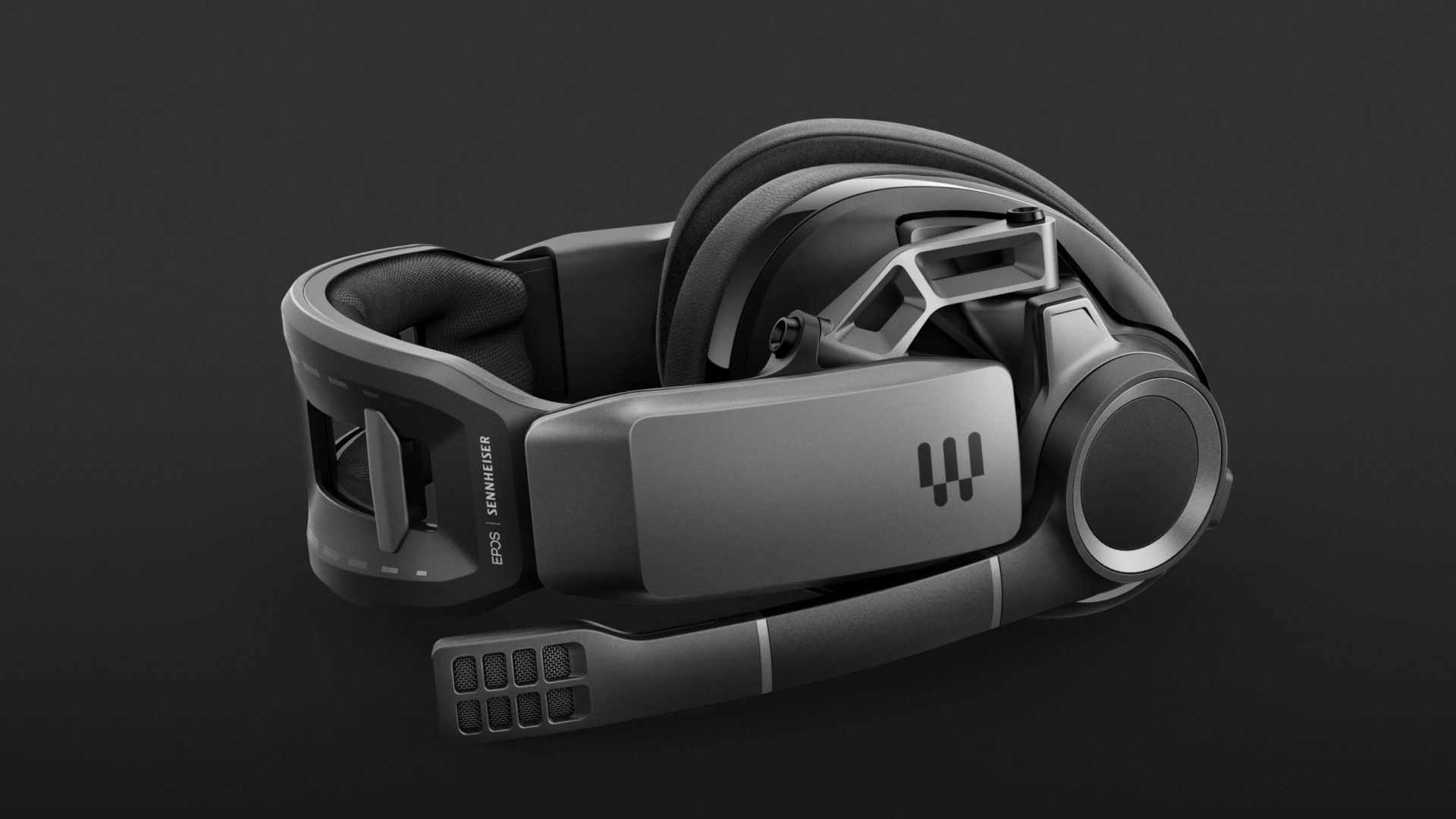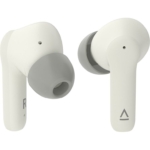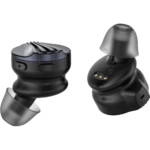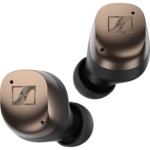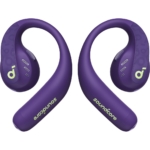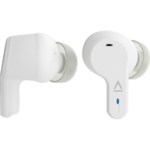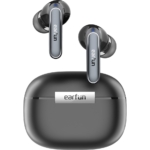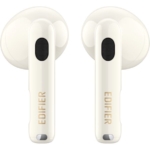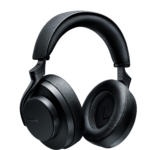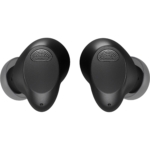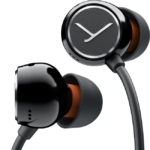The EPOS │ Sennheiser GSP 670 is a great headset, with very good sound and microphone, plus nice software, which is still expandable. For Windows 10 players, who may have a PlayStation 4 as a second device, it is a highly recommended headset! However, for other consoles too many possibilities are omitted, and you could also find much cheaper alternatives.
For sound and handling, however, there is no need to hide from the competition in the same price range. Some other manufacturers offer more features, and the really special ones, such as Head Tracking or THX, are missing, but the sound is quite bearable.
The GSP 670 is the top model in the gaming portfolio of EPOS │ Sennheiser and is clearly identifiable as a gaming headset: futuristic, with chunky design and a fixed microphone that can be folded up.
Although hardly anyone is likely to wear this on the road or on the train, it can, of course, be connected to mobile phones or tablets via Bluetooth. Connection via Bluetooth even has a positive effect on the battery performance, the manufacturer states 20+ hours. In addition, only 7 minutes per quick charge should be enough to be able to play for another 2 hours.
But the real highlight is the included USB dongle. Although this connection reduces the battery life by a good four hours, the advantages for PC users outweigh the disadvantages. The transfer is delay-free with this version, which is always a must for competitive games. In addition, this is the only way to access the EPOS Gaming Suite, the software which, as always, is designed to improve all the factory settings that may not be to your individual taste.
Connection
Connection is quite simple: plug the dongle into the USB port of your PC, turn on the headphones with the big knob and immediately a woman’s voice confirms with the words “Dongle connected”. The necessary software can be found on the EPOS homepage and is quick to install.
I had a positive surprise the first time I opened it – the EPOS Gaming Suite looks incredibly tidy, has a nice design for my taste and offers everything you need without being overloaded with functions. The whole thing is divided into three tabs, two of which deal with the sound of the headphones and microphone. In the first tab “Playback” the big equalizer catches the eye straight away. EPOS presents four profiles: “Music”, “Esport”, “Movie” and “Flat”. The latter brings all EQ bands back to 0. Nine bands are available for adjustment, which you can increase or decrease by 6 dB each. The three manufacturer’s specifications already intervene strongly in the curve and do not shy away from pushing one or more frequencies by a full 6 dB. A good start for hearing the different possibilities, but you might want to go back to the “flat” profile and start moving the frequencies yourself. When you are satisfied, just click on the “+” to save your profile.
Below the equalizer, the headset can then be switched from 2.0 to 7.1. This is an effect, 7.1 is simulated. To enhance this effect, sound reverberation can be added. If 7.1 is switched on, the sound is immediately wider than if you were sitting in a large room. If the effect is not yet clear enough, this size can be increased by adding sound reverberation. You should not exaggerate this, especially with voices, as it will eventually seem exaggerated and undifferentiated. Otherwise, this 7.1 sounds quite good for a virtual version. When playing games or watching movies it is even often an enrichment that can be switched on with just one mouse click. Basically, this should not be seen as the greatest strength of this stereo headset, but as an addition that in some cases enhances the sound experience. Otherwise, the 7.1 section in the software would be much more extensive.
The last item in the playback settings is the “sound test”. For this, you have to start a music source (MP3, YouTube or similar), because the sound test itself does not make any sound. However, if music is running in the background, all effects are switched on and off again alternately every 10 seconds. Which ones exactly and how strong is not shown, because there is only the EQ and 7.1 with reverberation.
Also in the second tab “Microphone” a big equalizer awaits us. But this time not to intervene directly in the frequencies, but to show what will happen in the end via the further settings. First of all, there is an effect called “Voice Amplifier”. If it is off, nothing happens, on “warm” lower frequencies are boosted, on “clear” the highs. This is followed by “amplification”, which is the volume. “Side Tone” adds your own voice to the game sound, so if you want to hear or control your own output, you can adjust it with this. The “Noise Gate” determines the level up to which the microphone will not let anything through. You can say goodbye to quiet background noises without any problems. The “noise suppression” additionally filters frequencies that you don’t want in the chat. All these changes are shown in the big EQ, which is really helpful for fine-tuning.
Tab 3 deals with the settings. Besides the status of the software, headset and dongle firmware, the “Smart button” is probably the most important feature here. This is the function button, which is located on the right headphone like the volume wheel. Unfortunately, when we tested them, only two functions could be assigned to this button, either switching through the profiles or switching from 2.0 to 7.1. However, this is to be expanded in the future.
Essentially, the software seems well designed, clear and well thought out, but somehow not quite finished. Behind the usual “?” many explanations are not complete. For example, the “noise reduction” as the last item in the microphone settings is completely missing here; other items are not displayed in their entirety. Sure, this may be due to the computer used, maybe also to the resolution, but if the headset is for PCs, the software should work everywhere. Maybe this is a case for the bug report, which can be found in the last tab. At least this shows that EPOS has an interest in fixing these problems.
Sound
The basic sound of the GSP 670 is very balanced. While many gaming headsets emphasise bass, the GSP 670 makes a very good impression in all areas of sound. This doesn’t mean that there is a lack of bass, but that mids and highs are also taken into account. The tuning of the frequencies results in a clear sound in the end, which does not lack any power. In a game, this means music is played beautifully, but also the small, fine background noises are clearly identifiable. And even in stereo mode, positions can be heard precisely. But with a frequency range of 10 Hz to 23 kHz and an equalizer that takes interventions from 64 Hz to 16 kHz, the right sound characteristics can be realised for every taste. This positive impression also makes the GSP 670 a great headset for music playback.
In 7.1 mode, the sound loses some of its clarity, which can be partially restored by EQ, but the mode is intended for other purposes, such as positioning.
Basically, it is highly gratifying that the basic tuning of the sound is so excellent that, without a doubt, you will have a great sound experience even without software.
Buttons, switches, connections etc
In addition to the volume wheel and the “smart button”, we find another wheel on the right ear, which controls chat volume. On the left side, there is a sync button for Bluetooth connection, the connector for the 1.5 m long charging cable and the microphone. When folded up, this is switched off. The dongle also has a button, so if there are any problems with the connection, just press it to synchronise with the headset.
The appropriate size is of course set on the headband. Additionally, the contact pressure can be adjusted on the upper side. Thus the GSP 670 sits firmly and securely on every head. At the same time, the headset, which weighs approx. 400 g, is never disturbing or unpleasant, either on the head or on the ears, which are completely enclosed by soft imitation leather.
The microphone of the EPOS │ Sennheiser GSP 670 is also very successful: the quality of speech is very good and with the help of various filters a reasonable signal can be sent to the chat in any situation. Of course, you can overdo it in the settings, but the microphone can’t do anything about that. The Noise Gate especially does a great job and thanks to the detailed display, it can be perfectly adjusted to suit the environment.
And on the couch?
As we’ve already written, the GSP 670 can be connected via Bluetooth to various other devices. Worthy of praise is that it uses Bluetooth 5.0, but only SBC is supported as a codec. In addition, an in-house codec has been installed, which is responsible for low latency audio and communication in combination with the GSA 70 USB dongle (included).
As a gaming headset it is, of course, primarily intended for Windows 10 and PlayStation 4 which is also controlled in conjunction with the dongle. But then you have to do without the features of the software as usual. In principle, all features are lost, except for the large volume wheel, which is actually an enhancement since you can adjust the volume directly on the headset. This is normally only possible in the Playstation menu, but the game must be paused briefly for this. The GSP 670 also does a good job on the PlayStation, the sound is very good despite the lack of fine-tuning by software and it is only in stereo. There’s nothing to complain about from the microphone either. The connection via dongle still has one advantage, because you are – in the truest sense of the word – not bound to the controller. Not only does this eliminate the usual cable, you can get up and go to the kitchen for a snack without a pad in your hand, but (assuming it’s only a short distance) you remain connected to the chat.
The GSP 670 simply lacks a 3.5 mm connector. Connected via USB dongle, Switch and Xbox One won’t connect. So if you have a full set of consoles in your TV cabinet, you won’t get an all-for-one-device here.
Finally, dual connectivity is certainly another useful feature for many people: here the headset is connected via dongle but at the same time, it allows a connection with a Smartphone via Bluetooth. So even when you’re dongled in, you’ll never miss a call again!
Technical specifications
- Ear couplingOver-ear
- Typeclosed
- Transducer principledynamic
- Frequency response (headphones)10 - 23.000 Hz
- Weight without cable398 g
- Cable length150 cm
What's in the box
- GSA 70 Dongle
- USB charging cable
Special features
- BT codecs: SBC
- BT version: 5.0
- Microphone frequency: 10 - 7,300 Hz








